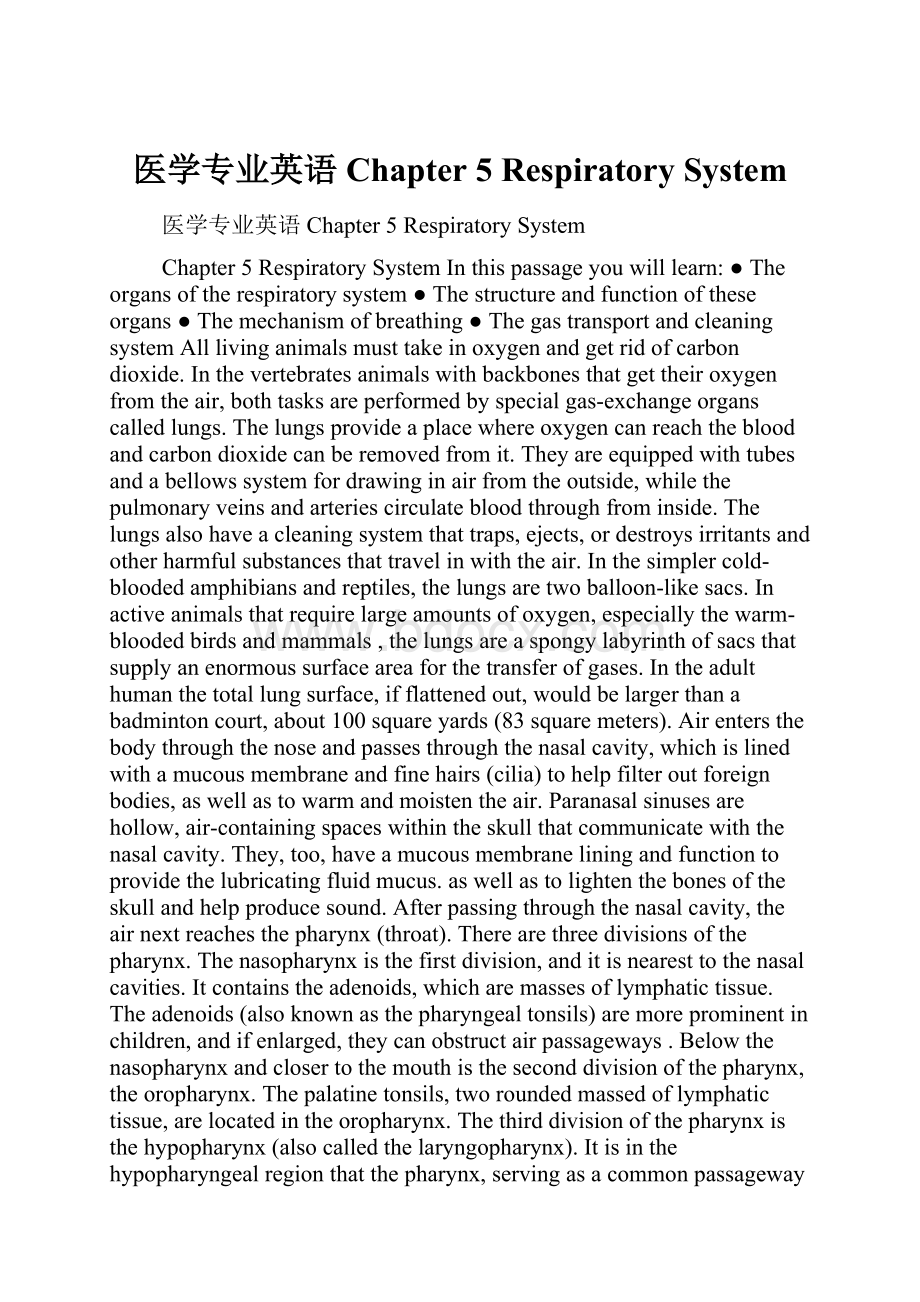医学专业英语 Chapter 5 Respiratory System.docx
《医学专业英语 Chapter 5 Respiratory System.docx》由会员分享,可在线阅读,更多相关《医学专业英语 Chapter 5 Respiratory System.docx(8页珍藏版)》请在冰豆网上搜索。

医学专业英语Chapter5RespiratorySystem
医学专业英语Chapter5RespiratorySystem
Chapter5RespiratorySystemInthispassageyouwilllearn:
●Theorgansoftherespiratorysystem●Thestructureandfunctionoftheseorgans●Themechanismofbreathing●ThegastransportandcleaningsystemAlllivinganimalsmusttakeinoxygenandgetridofcarbondioxide.Inthevertebratesanimalswithbackbonesthatgettheiroxygenfromtheair,bothtasksareperformedbyspecialgas-exchangeorganscalledlungs.Thelungsprovideaplacewhereoxygencanreachthebloodandcarbondioxidecanberemovedfromit.Theyareequippedwithtubesandabellowssystemfordrawinginairfromtheoutside,whilethepulmonaryveinsandarteriescirculatebloodthroughfrominside.Thelungsalsohaveacleaningsystemthattraps,ejects,ordestroysirritantsandotherharmfulsubstancesthattravelinwiththeair.Inthesimplercold-bloodedamphibiansandreptiles,thelungsaretwoballoon-likesacs.Inactiveanimalsthatrequirelargeamountsofoxygen,especiallythewarm-bloodedbirdsandmammals,thelungsareaspongylabyrinthofsacsthatsupplyanenormoussurfaceareaforthetransferofgases.Intheadulthumanthetotallungsurface,ifflattenedout,wouldbelargerthanabadmintoncourt,about100squareyards(83squaremeters).Airentersthebodythroughthenoseandpassesthroughthenasalcavity,whichislinedwithamucousmembraneandfinehairs(cilia)tohelpfilteroutforeignbodies,aswellastowarmandmoistentheair.Paranasalsinusesarehollow,air-containingspaceswithintheskullthatcommunicatewiththenasalcavity.They,too,haveamucousmembraneliningandfunctiontoprovidethelubricatingfluidmucus.aswellastolightenthebonesoftheskullandhelpproducesound.Afterpassingthroughthenasalcavity,theairnextreachesthepharynx(throat).Therearethreedivisionsofthepharynx.Thenasopharynxisthefirstdivision,anditisnearesttothenasalcavities.Itcontainstheadenoids,whicharemassesoflymphatictissue.Theadenoids(alsoknownasthepharyngealtonsils)aremoreprominentinchildren,andifenlarged,theycanobstructairpassageways.Belowthenasopharynxandclosertothemouthistheseconddivisionofthepharynx,theoropharynx.Thepalatinetonsils,tworoundedmassedoflymphatictissue,arelocatedintheoropharynx.Thethirddivisionofthepharynxisthehypopharynx(alsocalledthelaryngopharynx).Itisinthehypopharyngealregionthatthepharynx,servingasacommonpassagewayforfoodfromthemouthandairfromthenose,dividesintotwobranches,thelarynx(voicebox)andtheesophagus.Theesophagusleadsintothestomachandcarriesfoodtobedigested.Thelarynxcontainsthevocalcordsandissurroundedbypiecesofcartilageforsupport.Soundsareproducedasairisexpelledpastthevocalcords,andthecordsvibrate.Thetensionofthevocalcordsdeterminesthehighorlowpitchofthevoice.Sincefoodenteringfromthemouthandairenteringfromthenosemixinthepharynx,whatpreventsthepassingoffoodordrinkintothelarynxandrespiratorysystemafterithasbeenswallowed?
Evenwithasmallquantityofsolidorliquidmatterfindingitswayintotheairpassages,breathingcouldbeseriouslyblocked.Aspecialdeterrenttothiseventisprovidedforbyaflapofcartilageattachedtotherootofthetonguethatactslikealidoverthelarynx.Thisflapofcartilageiscalledtheepiglottis.Theepiglottisliesovertheentrancetothelarynx.Intheactofswallowing,whenfoodandliquidmovethroughthethroat,theepiglottisclosesoffthelarynx,sothatthesethingscannotenter.Onitswaytothelungs,airpassesfromthelarynxtothetrachea(windpipe),averticaltubeabout421incheslongand1inchindiameter.Thetracheaiskeptopenby16-20C-shapedringsofcartilageseparatedbyfibrousconnectivetissuethatstiffensthefrontandsidesofthetube.Intheregionofthemediastinum,thetracheadividesintotwobranchescalledbronchi.Eachbronchusleadstoaseparatelunganddividesandsubdividesintosmallerandfinertubes,somewhatlikethebranchesofatree(seeFigure6-1).DiaphragmFigure6-1Thesmallestofthebronchialbranchesarecalledbronchioles.Attheendofthebronchiolesareclustersofairsacscalledalveoli.Eachalveolusismadeofaone-celllayerofepithelium.Theverythinwallallowsfortheexchangeofgasesbetweenthealveolusandthecapillariesthatsurroundandcomeinclosecontactwithit.Thebloodthatflowsthroughthecapillariesacceptstheoxygenfromthealveolusanddepositscarbondioxideintothealveolustobeexhaled.Oxygeniscombinedwithahemoglobininerythrocytesandcarriedtoallpartsofthebody.Eachlungisenvelopedinadouble-foldedmembranecalledthepleura.Theouterlayerofthepleura,nearesttheribs,istheparietalpleura,andtheinnerlayer,closesttothelung,isthevisceralpleura.Thepleuraismoistenedwithaseroussecretionthatfacilitatesthemovementsofthelungswithinthethorax.Thetwolungsarenotquitemirrorimagesofeachother.Therightlung,whichistheslightlylargerofthetwo,isdividedintothreelobes,ordivisions,andtheleftlungisdividedintotwolobes.Itispossibleforonelobeofthelungtoberemovedwithoutdamagetotherest,whichcancontinuetofunctionnormally;Theuppermostpartofthelungiscalledtheapex,andthelowerareaisthebase.Thehilumofthelungisthemidlineregionwherebloodvessels,nerves,andbronchialtubesenterandexittheorgan.Thelungsextendfromthecollarbonetothediaphragminthethoraciccavity.Thediaphragmisamuscularpartitionthatseparatesthethoracicfromtheabdominalcavityandaidsintheprocessofbreathing.Thediaphragmcontractsanddescendswitheachinhalation(inspiration).Thedownwardmovementofthediaphragmenlargestheareainthethoraciccavityandreducestheinternalairpressure,sothatairflowsintothelungstoequalizethepressure.Whenthelungsarefull,thediaphragmrelaxesandelevates,makingtheareainthethoraciccavitysmaller,andthusincreasingtheairpressureinthethorax.Airthenisexpelledoutofthelungstoequalizethepressure;thisiscalledexhalation(expiration).Otherpartsarealsoinvolvedintheprocess.Thecycleofrespirationreallybeginswhenthephrenicnervestimulatesthediaphragmtocontractandflatten.Also,theintercostalmusclesbetweentheribsaidininspirationbypullingtheribsupandout.Themeasureofhoweasilythelungsexpandunderpressureiscompliance.Breathingisregulatedunconsciouslybycenterinthebrainstem.Thesecentersadjusttherateandrhythmofbreathingaccordingtochangesinthecompositionoftheblood,especiallytheconcentrationofcarbondioxide.GasTransport.Oxygeniscarriedinthebloodboundtohemoglobininredbloodcells.Theoxygenisreleasedtothecellsasneeded.Carbondioxideiscarriedinseveralways,butismostlyconvertedtoanacidcalledcarbonicacid.Theamountofcarbondioxidethatisexhaledisimportantinregulatingtheacidityoralkalinityoftheblood.Iftoomuchcarbondioxideisexhaledbyhyperventilation,bodyfluidstendtobecomemorealkaline,aconditiontermedalkalosis.Iftoolittlecarbondioxideisexhaledasaresultofhypoventilation,bodyfluidstendtobecomemoreacid,aconditiontermedacidosis.Thecleaningsystemofthelungshasfourmaincomponents.Liningthetracheaandbronchialtreearecellsthatsecretemucus,whichtrapspollutantsandbacteria.Alsointhebronchiarecellscontainingtinycilia,thatprojectintotheblanketofmucusandwithconstantwavelikemotionspushthemucusupoutoftheairways.Irritatingchemicals,stagnantandexcessivemucus,andlargebitsofforeignmatterareforciblyejectedassputumfromthebronchibyacough.Thisthirdimportantcleaningdevicelikebreathing,underpartialvoluntarycontrolisarapidmusclecontractionandbronchial-tubeconstrictionthatgeneratesawindforcefarstrongerthanatornado.Smallharmfulsubstancesthatmaketheirwayintothealveoliaredestroyedbythefourthlineofdefense,themacrophages.Thesearepatrollingcellsthatswallowupforeignparticlesordestroythemwithenzymes.NewWordsandPhrasesExercisesA.Discussthefollowingtopics:
1.Imagineyouwerelecturinginfrontofruralhealthworkersonthetopicofrespiratorysystem,drawapicturetoillustratethewholesystem.2.Describetheirstructuresandfunctions.3.Howcanepiglottispreventthepassingfoodanddrinkintotherespiratorysystem?
4.Whatroledoesthediaphragmplayintheprocessofbreathing?
5.Whatarethefourcomponentsofthecleaningsystem?
Howdotheyfunction?
B.Fillintheblankswiththewordsgivenbelowandchangetheirformsifnecessary.alveoluscapillarydiaphragmhemoglobinthoraciccavitygasexchangeparietalpleuravisceralpleuramediastinumpleuralspaceThelungsaretwocone-shaped,spongyorgansconsistingofalveoli,bloodvessels,elastictissueandnerves.Eachofthetwolungsconsistsofsmallerdivisionscalledlobes;theleftlunghastwolobes,whiletherightlungisdividedintothreelobes.Inthelungs,
(1)aresurroundedbyanetworkoftinybloodvesselscalledcapillaries;oxygenfromthelungspassesintothese
(2)fordistributiontotissuecells,whilecarbondioxidefromthebloodpassesintothelungstobeexpelledbyexhalation.Onceabsorbedintobloodcells,oxygenbecomesattachedto(3)andisreleasedtotissuecellsasneeded.Thus,theprimaryfunctionofthelungsistobringairintoclosecontactwithblood,whichallows(4)tooccur.Thelungsaresurroundedbyamembranecalledthe(5